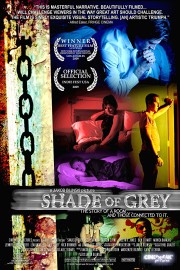Shade of Grey
Writer-director Jakob Bilinski’s feature debut “Shade of Grey” is a curious, sometimes beautiful, but a lot of times dramatically unsure drama. The film is based around a fascinating structure, telling each of its stories within the confines of a single hotel room and in a way, telling the story of the room itself. The secrets it contains. The happiness it has seen. And the pain events have caused to the people who visit it. It’s a very different film from Bilinski’s excellent short film “Foxxy Madonna vs. The Black Death,” but it’s no less assured technically or in the story it wants to tell.
To try and recount each of the stories the film tells would probably result in a brain freeze on my part; there are so many characters, and so many different plot strands. The main story we see is that of a marriage falling apart as Evan (Scott Ganyo) and Samantha (Katelyn Coyne) try to find comfort in the arms of others. They had their wedding night in the hotel, and Evan has been coming here with Samantha’s sister Nicole (Jennifer Berkemeier) for a while now. We also see the young love of Bryan (Ben Schmitt) and Sarah (Monica Barajas), first as they make love, later when they come to the room after Sarah has become pregnant from that first time, and is ready to deliver. But Bryan isn’t sure about whether they’ll be able to support a child, although he should be more concerned about living when a drug deal he’s involved in threatens to get messy.
These are just a few of the plot strands and scenes we see. There’s also a wild party that ends with a man dead in the room’s bed and a beautiful final scene where a young man (who has never been in the room before) checks in, and looks around. That scene works, as do many others in this 80-minute film. Not everything works. As assured as Bilinski is as a filmmaker, some of the performances are too flat to really resonate with the viewer. But when you see the film through to the end, it probably won’t matter; the point is the overall mood and theme of the film, which I think is that every room has a story to tell. Some are painful, some are poignant, and some are the happiest a person’s ever been. But each one has its place in the larger universe, which is filled with many shades of grey, even if it’s more than we would like.










